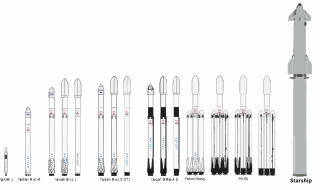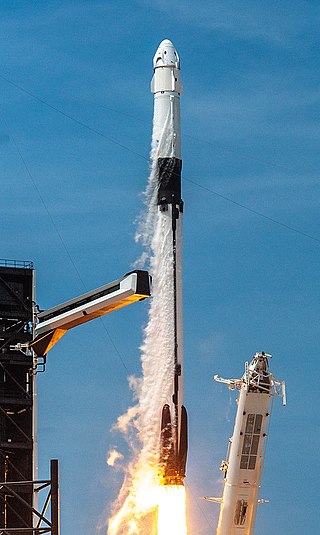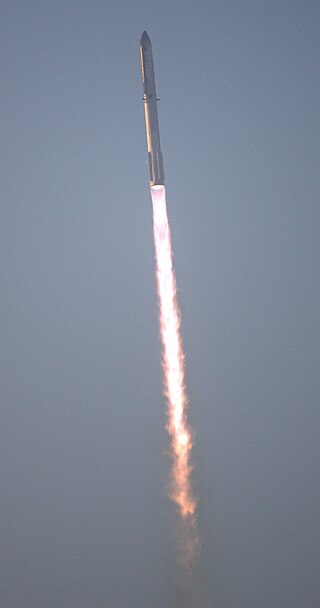
A reusable launch vehicle has parts that can be recovered and reflown, while carrying payloads from the surface to outer space. Rocket stages are the most common launch vehicle parts aimed for reuse. Smaller parts such as rocket engines and boosters can also be reused, though reusable spacecraft may be launched on top of an expendable launch vehicle. Reusable launch vehicles do not need to make these parts for each launch, therefore reducing its launch cost significantly. However, these benefits are diminished by the cost of recovery and refurbishment.

Space Exploration Technologies Corporation, commonly referred to as SpaceX, is an American spacecraft manufacturer, launch service provider and satellite communications company headquartered in Hawthorne, California. The company was founded in 2002 by Elon Musk with the goal of reducing space transportation costs and ultimately developing a sustainable colony on Mars. The company currently produces and operates the Falcon 9 and Falcon Heavy rockets along with the Dragon and Starship spacecraft.

SpaceX manufactures launch vehicles to operate its launch provider services and to execute its various exploration goals. SpaceX currently manufactures and operates the Falcon 9 Block 5 family of medium-lift launch vehicles and the Falcon Heavy family of heavy-lift launch vehicles – both of which are powered by SpaceX Merlin engines and employ VTVL technologies to reuse the first stage. As of 2024, the company is also developing the fully reusable Starship launch system, which will replace the Falcon 9 and Falcon Heavy.

SpaceX has privately funded the development of orbital launch systems that can be reused many times, similar to the reusability of aircraft. SpaceX has developed technologies over the last decade to facilitate full and rapid reuse of space launch vehicles. The project's long-term objectives include returning a launch vehicle first stage to the launch site within minutes and to return a second stage to the launch pad, following orbital realignment with the launch site and atmospheric reentry in up to 24 hours. SpaceX's long term goal would have been reusability of both stages of their orbital launch vehicle, and the first stage would be designed to allow reuse a few hours after return. Development of reusable second stages for Falcon 9 was later abandoned in favor of developing Starship, however, SpaceX developed reusable payload fairings for the Falcon 9.

Starbase is an industrial complex for Starship rockets, located near Brownsville, Texas, United States. It has been under construction since the late 2010s by SpaceX, an American aerospace manufacturer. Starbase is composed of a spaceport near the Gulf of Mexico, a production facility at the Boca Chica village, and a small structure test site along the Texas State Highway 4.

As of 2023, SpaceX operates four launch facilities: Cape Canaveral Space Launch Complex 40 (SLC-40), Vandenberg Space Force Base Space Launch Complex 4E (SLC-4E), Kennedy Space Center Launch Complex 39A (LC-39A), and Brownsville South Texas Launch Site (Starbase). Space Launch Complex 40 was damaged in the AMOS-6 accident in September 2016 and repair work was completed by December 2017. SpaceX believes that they can optimize their launch operations, and reduce launch costs, by dividing their launch missions amongst these four launch facilities: LC-39A for NASA launches, SLC-40 for United States Space Force national security launches, SLC-4E for polar launches, and South Texas Launch Site for commercial launches.

Falcon 9 Full Thrust is a partially reusable medium-lift launch vehicle, designed and manufactured by SpaceX. It was first designed in 2014–2015, with its first launch operations in December 2015. As of 29 May 2024, Falcon 9 Full Thrust had performed 321 launches without any failures. Based on the Laplace point estimate of reliability, this rocket is the most reliable orbital launch vehicle in operation.

A super heavy-lift launch vehicle is a rocket that can lift to low Earth orbit a "super heavy payload", which is defined as more than 50 metric tons (110,000 lb) by the United States and as more than 100 metric tons (220,000 lb) by Russia. It is the most capable launch vehicle classification by mass to orbit, exceeding that of the heavy-lift launch vehicle classification.

New Glenn is a heavy-lift orbital launch vehicle developed by Blue Origin, named after NASA astronaut John Glenn, the first American astronaut to orbit Earth. New Glenn is a two-stage rocket with a diameter of 7 m (23 ft). Its first stage is powered by seven BE-4 engines that are also designed and manufactured by Blue Origin. It is intended to launch from Cape Canaveral Launch Complex 36, with the first stage landing on a barge in Port Canaveral.The inaugural vehicle was unveiled on the launch pad in February 2024.

Starship is a two-stage super heavy-lift launch vehicle under development by SpaceX. As of May 2024, it is the largest and most powerful rocket ever flown. Starship's primary objective is to lower launch costs significantly via economies of scale. This is achieved by reusing both rocket stages, increasing payload mass to orbit, increasing launch frequency, creating a mass-manufacturing pipeline, and adapting it to a wide range of space missions. Starship is the latest project in SpaceX's decades-long reusable launch system development program and ambition of colonizing Mars.

Falcon 9 Block 5 is a partially reusable two-stage-to-orbit medium-lift launch vehicle designed and manufactured in the United States by SpaceX. It is the fifth version of Falcon 9 Full Thrust, powered by SpaceX Merlin engines burning rocket-grade kerosene (RP-1) and liquid oxygen (LOX).
SpaceX Starship flight tests include fourteen launches of prototype rockets during 2019–2024 for the SpaceX Starship launch vehicle development program. Eleven test flights were of single-stage Starship spacecraft flying low-altitude tests (2019–2021), while three were orbital trajectory flights of the entire Starship launch vehicle (2023–2024), consisting of a Starship spacecraft second-stage prototype atop a Super Heavy first-stage booster prototype. None of the flights to date has carried an operational payload. More flight tests are planned in 2024 and 2025.

Raptor is a family of rocket engines developed and manufactured by SpaceX. The engine is a full-flow staged combustion cycle (FFSC) engine powered by cryogenic liquid methane and liquid oxygen ("methalox").

Starship HLS is a lunar lander variant of the Starship spacecraft that is slated to transfer astronauts from a lunar orbit to the surface of the Moon and back. It is being designed and built by SpaceX under the Human Landing System contract to NASA as a critical element of NASA's Artemis program to land a crew on the Moon.
Boca Chica is an area on the eastern portion of a subdelta peninsula of Cameron County, at the far south of the US State of Texas along the Gulf Coast. It is bordered by the Brownsville Ship Channel to the north, the Rio Grande and Mexico to the south, and the Gulf of Mexico to the east. The area extends about 25 miles (40 km) east of the city of Brownsville. The peninsula is served by Texas State Highway 4—also known as the Boca Chica Highway, or Boca Chica Boulevard within Brownsville city limits—which runs east–west, terminating at the Gulf and Boca Chica Beach.

SpaceX Starship integrated flight test 1 (IFT-1) was the first integrated flight test of the SpaceX Starship launch vehicle. SpaceX performed the flight test on April 20, 2023. The prototype vehicle was destroyed less than four minutes after lifting off from the SpaceX Starbase in Boca Chica, Texas. The vehicle became the most powerful rocket ever flown, breaking the half-century-old record held by the Soviet Union's N1 rocket.

Super Heavy is the first stage of the SpaceX Starship super heavy-lift launch vehicle, which it composes in combination with the Starship second-stage. As of 2024, Super Heavy prototypes are being flight tested. Super Heavy flew for the first time on April 20, 2023, during the first orbital launch attempt of the Starship rocket.

Starship is a spacecraft and second stage under development by American aerospace company SpaceX. Stacked atop its booster, Super Heavy, it composes the identically named Starship super heavy-lift space vehicle. The spacecraft is designed to transport both crew and cargo to a variety of destinations, including Earth orbit, the Moon, Mars, and potentially beyond. It is intended to enable long duration interplanetary flights for a crew of up to 100 people. It will also be capable of point-to-point transport on Earth, enabling travel to anywhere in the world in less than an hour. Furthermore, the spacecraft will be used to refuel other Starship vehicles to allow them to reach higher orbits and other space destinations. Elon Musk, the CEO of SpaceX, estimated in a tweet that 8 launches would be needed to completely refuel a Starship in low Earth orbit, extrapolating this from Starship's payload to orbit and how much fuel a fully fueled Starship contains. To land on bodies without an atmosphere, such as the Moon, Starship will fire its engines and thrusters to slow down.

SpaceX Starship Integrated Flight Test 2 (IFT-2) was the second integrated flight test of SpaceX Starship launch vehicle. SpaceX performed the flight test on November 18, 2023. The mission's primary objectives were for the vehicle to hot stage—a new addition to Starship's flight profile—followed by the second stage attaining a near-orbital trajectory with a controlled reentry over the Pacific Ocean, while the booster does a boostback burn with a propulsive splashdown in the Gulf of Mexico.

SpaceX Starship integrated flight test 4 (IFT-4) will be the fourth integrated flight test of a prototype Starship launch vehicle. The prototype vehicles planned to be flown are the Ship 29 upper-stage and Booster 11.

















